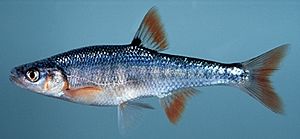Rosefin shiner facts for kids
Quick facts for kids Rosefin shiner |
|
|---|---|
 |
|
| Conservation status | |
| Scientific classification | |
| Synonyms | |
|
The rosefin shiner (Lythrurus ardens) is a cool type of fish found in the United States. This fish eats both plants and animals, making it an omnivore. You can find it swimming in freshwater rivers and creeks in states like Virginia, North Carolina, and West Virginia.
Contents
About the Rosefin Shiner
The rosefin shiner has a long, thin body. It has special fins that help it swim. It has eight rays in its dorsal fin (the one on its back), nine to eleven rays in its anal fin (underneath), thirteen to fourteen rays in its pectoral fins (on its sides), and eight rays in its pelvic fins (on its belly).
One way to tell a rosefin shiner apart from other fish is a dark spot. This spot is found at the base of its first few dorsal fins. It also has a stripe along its side that fades near its back. Plus, there are several colored bands across its back.
Where Rosefin Shiners Live
You can find rosefin shiners all over Virginia, North Carolina, and West Virginia. Sometimes, these fish end up in new places by accident. For example, people think they were introduced to the York River in Virginia. This might have happened when they were used as bait and then escaped into the water.
These fish live in freshwater pools, rivers, and creeks. They like water that is clear or a bit cloudy. You usually won't find them in streams where trout live. When winter comes, rosefin shiners often move to deeper, calmer waters.
What Rosefin Shiners Eat and Do
The rosefin shiner is an omnivore, meaning it eats many different things. Its diet includes tiny insect larvae called chironomids, mayflies, other aquatic insects, and even plants.
Reproduction and Life Cycle
Rosefin shiners lay their eggs, a process called spawning, in fast-moving water. They tend to stay in these speedy waters until winter arrives. What's really interesting is that they often lay their eggs at the same time and in the same nest as another fish, the longear sunfish. These two fish species actually work together to protect their shared nest from other animals that might try to eat the eggs.
Conservation Status
Good news for the rosefin shiner! Its population is generally stable, which means there are plenty of them around. They live in a large area and have a healthy number of fish. Also, there aren't any big threats that could harm their survival. Because of these reasons, scientists don't believe this fish is at risk of disappearing.
See also
 In Spanish: Lythrurus ardens para niños
In Spanish: Lythrurus ardens para niños


